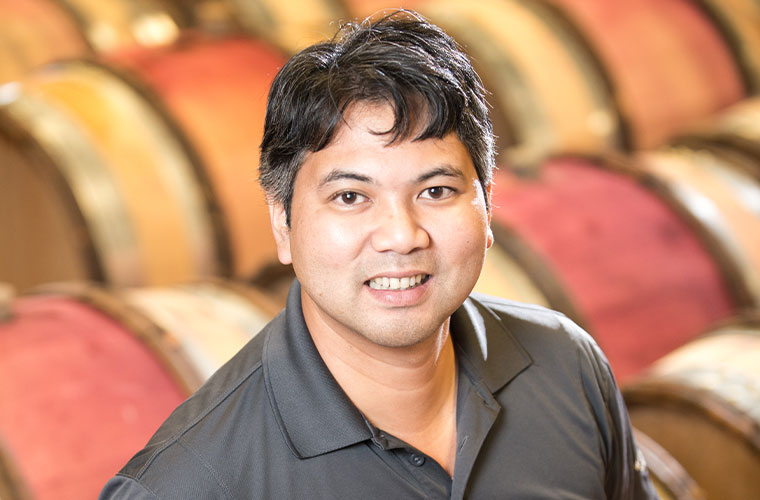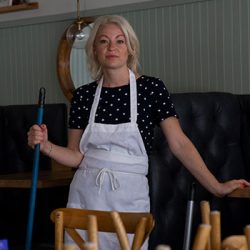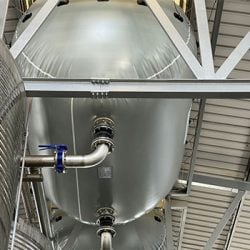

Jeff Mangahas is vice president and director of winemaking at Williams Selyem in the Russian River Valley. Mangahas, 50, graduated from the University of Washington in 1993 with a B.S. in cellular and molecular biology; for several years he worked as a cancer-research technologist, first in Seattle and later at Princeton University and a pharmaceutical firm in New York. But increasingly, Mangahas (who cut his teeth, so to speak, on Washington State cabernet) found himself fascinated by wine, not least in the science that made it taste the way it did. That culminated in enrollment at the University of California at Davis, where he obtained an M.S. in viticulture and enology in 2003.
Having migrated in his personal allegiance from Bordeaux varieties to the “specialness of pinot noir,” Mangahas proceeded to work for Artesa, Dutton-Goldfield and Hartford Court before joining Bob Cabral at Williams Selyem in 2011. When Cabral departed two years later, Mangahas took over as winemaker.
“Science serves me well in terms of deductive reasoning and problem solving,” Mangahas says of his career switch. “My brain is a blend of science and artistry.” We talked to him about his analytical approach to the current drought. —David Darlington
(This interview has been edited and condensed.)
We only had 14 inches of rain this growing season. Normally it’s 28 or 32, but it’s not really affecting us yet, per se. Plants don’t need a lot of water at this stage in the season—not until we get closer to harvest. We did some irrigation prior to flowering because a certain amount of water is required for [that], and to set all the berries on clusters. And a couple of weeks ago we irrigated, fortuitously, in advance of a heat wave. We have soil moisture probes that monitor how much the plants need; some vineyards still have moisture in the soil, but where it’s a little bit weaker, we want to be pro-active and give them something to sip on. The temperature that week got up to 105 degrees, but [the following week], surprisingly or not, the plants looked fine. They’re smart enough to shut down when conditions are severe—there’s very little transpiration, so they’re preserving water, basically. I saw very little damage to the leaves themselves, though I did see a few individual berries starting to shrivel up, particularly on the afternoon side of plants where they’re beaten down by intense sun. By the time harvest comes around, those are going to dry up and be nonexistent. So the extent of damage is yet to be determined.
An old-vine zinfandel vineyard that we source from [on Wood Road near Fulton] has no irrigation whatsoever. It gets disced aggressively to reduce competition in the vine row, and it does an amazing job of preserving soil moisture. Those are very old plants, with big roots and an ability to mine water from really deep down. They survived just fine—happy as clams. It’s a testament to why these vineyards have lived for 120-plus years. In seasons like this, dry-farmed vineyards can definitely do better; today a lot of rootstocks have smaller roots—they produce really nice wine, but you can’t effectively dry-farm them.
Pinot noir is a little different—it can be more susceptible to heat. Thicker-skinned clones are better for resilience. I favor a couple like Pommard and “heirlooms” like Martini, Mount Eden and Swan—clones that tend to hold their acidity but also have thicker skins and are less likely to dehydrate in warm conditions. They have more pulp; Dijon clones are juicier. In a really cold site, like on the coast, Dijon is perfect—it was bred to ripen faster and better in a cool climate. But our estate is in the Middle Reach of the Russian River Valley—a warmer microclimate within a cool growing region. There’s less fog intrusion, the soil is drier and bud break and harvest are earlier. I’m usually one of the first people picking in the Russian River Valley; in a typical year, I’m harvesting as early as August 10, partly because of where the grapes are, but also because of the precision of how we farm.
We’re pretty fanatical about crop adjustments. With pinot noir, the time from flowering to harvest (at around 23° Brix) is about 110 days; phase one, up to about day 60, is for growing and development of berries. Days 67 to 110 are the ripening phase, when sugar is accumulating and acid is going down, with no physical growth. The week in between is called the “lag” phase, and I’m adamant that’s when you need to adjust your crop. The plant tries to set a crop whether it has little tiny shoots or big vigorous shoots, so depending on the weight of the clusters and how many there are—I shoot for three tons per acre for pinot noir—we get rid of the short shoots and any additional clusters. If you get that right, you go into the ripening phase more balanced—you tighten up your window and can pick at 22.8° or 23° Brix, because you’ve gotten rid of fruit that isn’t going to ripen. If you leave that to the very end, you’ve taken the energy to ripen away from the plant. Later in the season there’s more risk of rain, and now even fire and smoke issues. Up to the lag phase, grapes are still pretty hard, but in the second period when things start to soften and turn color, intense heat can definitely cause damage.
Another tactic we’re using, in our more delicate blocks, is shade cloth during the most susceptible (the hottest) time. I talked to our vineyard manager yesterday, and we’re going put it up pretty soon. It’s only June, and though it’s not unprecedented [to have heat waves so early], my head’s turning and thinking: Wow, we still have a lot of hot, dry growing season left. We want to protect the fruit as much as possible. The reason you irrigate later in the season is you don’t want to stress the plants out too much when they’re trying to ripen grapes; when that happens, the leaves turn yellow and they’re not photosynthesizing. That may be an issue later in the season—we just don’t know yet. One of the levers you can pull later is dropping crop, because the more crop you have, the more extended the season. If you’re racing to harvest and don’t have water, you don’t want to delay picking.
In our estate vineyards, we’re okay . We have very senior riparian water rights from the Russian River [with wells grandfathered in at Williams Selyem], but we buy grapes from all over the place. I have 29 vineyards—mostly in the Russian River Valley, but also the Sonoma Coast, Anderson Valley, the Central Coast and, these days, a little cabernet from Napa Valley. Some of those vineyards tend to capture water during the rainfall season and divert it into ponds, and some of those have very little water. Ours doesn’t come directly from the river, but from the underflow or underground aquifer. The wells were put in place many years ago, but if the river were completely drained down, that source might no longer exist.
We have a dedicated fire tank on the property that holds 70,000 gallons, and a dedicated fire pump hooked up to a generator. Last year, the Wallbridge fire started from a lightning strike 15 or 20 miles west of here, and worked its way within two and a half miles of our winery. But in between there are lots of vineyards, which tend to act as pretty good firebreaks. There’s still a lot of fuel around here, oak trees and so forth—so, in the moment, I was concerned about it. But thinking about it in calmer times, [our vulnerability] is pretty low. Our building is concrete with a metal roof; it doesn’t get better than that for fire safety, and the Russian River is the best firebreak of all, so fire’s not going to encroach from the east. More than anything, my concerns would be people’s safety—and smoke taint.
Last year, it didn’t matter where you were—2020 had multiple fires up and down the West Coast. When the Wallbridge fire started, we were already picking, but some of our vineyards weren’t ready until 25 or 30 days after that. So there were definitely some things I didn’t pick, and some wines we didn’t make or were dumped down the drain. In 2008, fires happened before veraison. The main one was in Mendocino—it started up on one of the ridges and affected a lot of the Sonoma Coast. That was a vintage where—anecdotally, because we didn’t have many [analytical] tools then—wines that had a little bit of smokiness developed more smoke characters in the bottle. [Those smoke characters] became liberated with time. Today we have more robust tests, but there are tons of factors we still don’t know about from a scientific perspective—about the compounds themselves, and the mechanisms once they’re inside the plant. To some degree, the level of glycosylation [uptake and sequestering of smoke volatiles] depends on the timing of fire and level of exposure—when grapes are exposed and for how long—but it turns out that a lot of smoke compounds are ubiquitous in the atmosphere anyway. They exist in nature in non-smoky years, and some grape varieties naturally have measurable smoke-related compounds. Syrah and mourvedre have a meaty quality that’s related to the exact same compounds we test for smoke taint. So even though I understand the science, it’s still confusing to look and see what’s tainted and what’s not.
The other confounding thing is that toasted oak barrels have those compounds, too. This past year, I made a model wine and aged it in new oak to help me understand what compounds are oak-derived and which ones come from the grapes. There’s just a mess of variables to muddle though. Ultimately it comes down to taste, but I can’t help myself—I have a science background, so I believe that science should lead us to all of the answers.
W&S's James Beard Award—winning special correspondent David Darlington is the author of five books, among them An Ideal Wine and Angels' Visits: An Inquiry into the Mystery of Zinfandel (later retitled Zin).
This is a W&S web exclusive. Get access to all of our feature stories by signing up today.


















